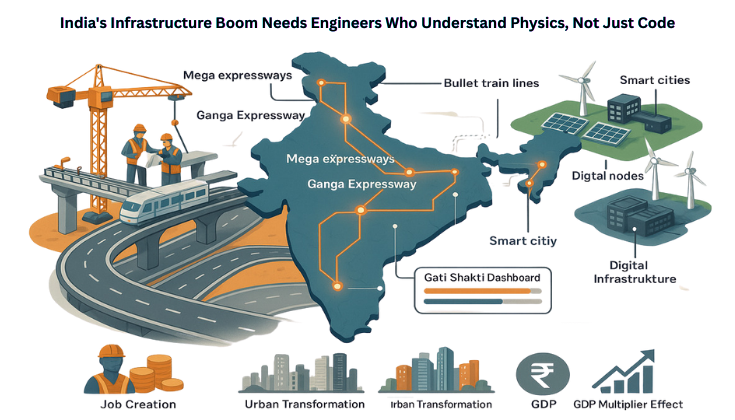

India’s Infrastructure Boom Needs Engineers Who Understand Physics, Not Just Code
“India is not just building roads and metros. We’re building resilience, safety, and the future. And that needs engineers who know physics — not just programming.”
In the rush toward automation, coding bootcamps, and AI-led education, one important truth is often overlooked:
The physical world still matters.
India is entering a once-in-a-century infrastructure transformation — from smart cities to bullet trains, expressways to high-rise structures, EV charging grids to underground metros.
And to design, simulate, and maintain this new India, we need engineers who understand force, load paths, material behavior, fatigue, vibrations, and real-world constraints — not just algorithms and syntax.
🇮🇳 India’s $1.4 Trillion Infrastructure Push: An Engineering Testbed
Under programs like Gati Shakti, Bharatmala, Smart Cities Mission, and PM Gati Shakti Master Plan, India is seeing:
- 35+ new metro projects
- 25,000+ km of national highways
- Bullet train corridors (Mumbai–Ahmedabad)
- Smart infrastructure integration
- Green building mandates
- EV manufacturing zones
These are not just civil projects. They are complex systems involving:
- Dynamic loading
- Seismic resistance
- Long-term durability
- Fatigue & fracture mechanics
- Aerodynamic and fluid-structure interactions
- Vibration and noise control in urban environments
Who’s Building This? Not Just Coders.
You cannot design a bridge pier with Java.
You cannot simulate a tunnel under seismic loading using HTML.
You cannot calculate fatigue life of a metro wheel with a chatbot.
These challenges require engineers who know structural dynamics, fluid mechanics, thermodynamics, control systems, material science, and simulation.
In short, engineers with deep physics awareness + modern tools.
Why Physics-Based Thinking Is the Future of Engineering
The most resilient infrastructure systems are not “coded” into existence.
They are modeled, simulated, tested, and optimized.
And that requires:
| Skill | Why It Matters |
| Statics & Dynamics | For load transfer, response prediction |
| Material Science | To select the right materials for durability |
| Fatigue & Fracture | For railway bogies, bridges, pavements |
| Vibration & NVH Analysis | For noise control in metros, flyovers |
| Thermal & CFD Analysis | For tunnels, HVAC, energy systems |
| Simulation Tools (CAE) | For pre-validation and optimization |
| Python + AI for Engineering | For predictive modeling and real-time data interpretation |
These are not optional anymore — they are mission-critical.
Real-World Tools for Real Engineering Problems
Students today must be trained in tools that industry actually uses. At ELENO COE, we focus on:
- LS-DYNA: Impact, crash, blast simulation
- Abaqus: Non-linear durability simulation
- Ansys Mechanical/Fluent: Thermal + structural
- HyperMesh: Advanced meshing and FE modeling
- nCode: Fatigue life estimation for bridges, bogies, and more
- Python: For CAE post-processing, AI models
- Simcenter/Nastran: NVH and modal behavior
In India’s growing infrastructure ecosystem, simulation is the new drawing board.
What This Means for Students and Colleges
Colleges:
Stop teaching just the theory. Begin integrating simulation-based, project-driven engineering education. Students must learn how to model, simulate, and analyze real-world infrastructure systems.
Students:
If you’re in Civil, Mechanical, Electrical, or Electronics — upskill in simulation.
You are more needed than ever. Learn to speak the language of:
- Load cases
- Boundary conditions
- Failure criteria
- Dynamic events
- Optimization under constraints
These are your real tools, not just your syllabus.
Final Message to Industry, Parents & Academia
India doesn’t just need coders.
India needs a new generation of simulation-ready, physics-first engineers.
Engineers who can:
✅ Predict how a structure will behave under extreme loads
✅ Design tunnels that survive earthquakes
✅ Optimize bridges for fatigue life
✅ Simulate dynamic wind effects on high-rises
✅ Manage vibration in urban rail systems
✅ Improve safety through CAE, not just field trials
This is where India’s real engineering future lies.
📞 Contact Nachiket: 9881732144
🌐 Explore simulation-based career programs: www.eleno-elc.com


